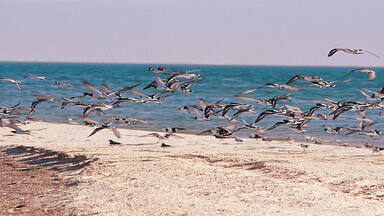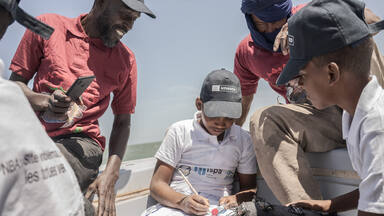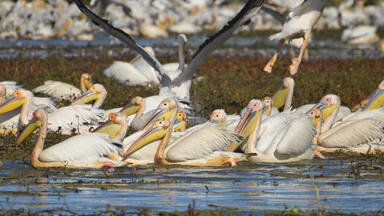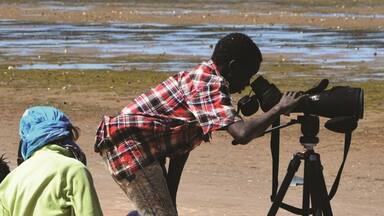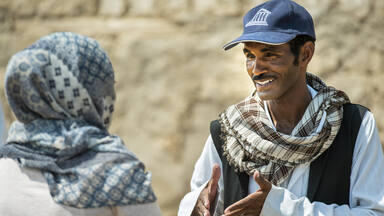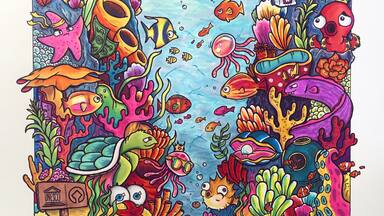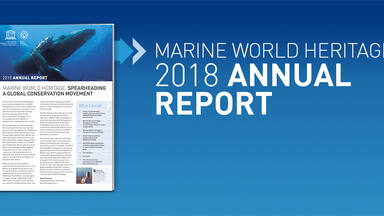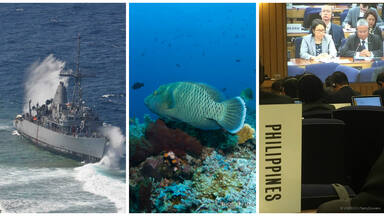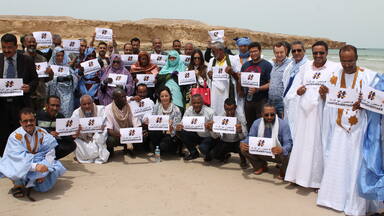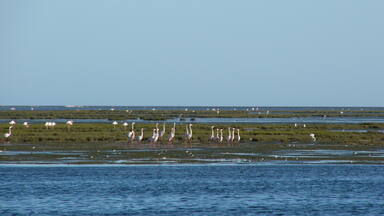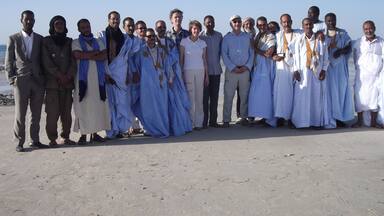Banc d'Arguin National Park
Banc d'Arguin National Park
Fringing the Atlantic coast, the park comprises sand-dunes, coastal swamps, small islands and shallow coastal waters. The contrast between the harsh desert environment and the biodiversity of the marine zone has resulted in a land- and seascape of outstanding natural significance. A wide variety of migrating birds spend the winter there. Several species of sea turtle and dolphin, used by the fishermen to attract shoals of fish, can also be found.
Description is available under license CC-BY-SA IGO 3.0
Parc national du banc d'Arguin
Situé le long de la côte atlantique, ce parc est formé de dunes de sable, de zones côtières marécageuses, de petites îles et d'eaux littorales peu profondes. L'austérité du désert et la richesse biologique de la zone marine créent un paysage terrestre et marin exceptionnellement contrasté. Une remarquable diversité d'oiseaux migrateurs y passent l'hiver. On y trouve également plusieurs espèces de tortues marines ainsi que des dauphins, que les pêcheurs utilisent pour rabattre les bancs de poissons.
Description is available under license CC-BY-SA IGO 3.0
المنتزه الوطني بانك دارغوين
يتألَّف هذا المنتزه الذي يقع على طول الساحل الاطلسي من تلالٍ رمليّةٍ ومن مناطقَ ساحليّةٍ مستنقعيّة ومن جزر صغيرة ومن مياه ساحلية غير عميقة. فقسوة الصحراء والثروة البيولوجية في المنطقة البحرية تشكّلان منظراً أرضيًا وبحريًا متناقضًا بامتياز، حيث تمضي العصافير المهاجرة الفريدة التنوّع فصل الشتاء. وفي هذا المنتزه أيضًا، عدّة أنواع من السلاحف البحريّة، بالاضافة الى الدلافين التي يستعملها الصيادون لتوجيه مسار أسراب السمك.
source: UNESCO/CPE
Description is available under license CC-BY-SA IGO 3.0
阿尔金岩石礁国家公园
阿尔金岩石礁国家公园位于大西洋海岸,由沙丘、海岸沼泽、小岛和浅海湾构成。贫瘠的荒漠环境以及沿海地区的多样性,使得陆地与海岸的自然风光形成了强烈对照。种类繁多的候鸟在这里越冬。渔民们用来吸引大量鱼群的几种海龟和海豚在这里也可以找到。
source: UNESCO/CPE
Description is available under license CC-BY-SA IGO 3.0
Национальный парк Банк д`Арген
Парк располагается на побережье Атлантического океана и включает песчаные дюны, прибрежные болота, небольшие острова и мелководье. В переходной зоне между знойной пустыней и океаном сформировались исключительно ценные природные комплексы. Самые разнообразные мигрирующие птицы прилетают сюда на зимовку. Здесь обитают морские черепахи нескольких видов, а также дельфины, которых местные рыбаки используют для загона косяков рыбы.
source: UNESCO/CPE
Description is available under license CC-BY-SA IGO 3.0
Parque Nacional del Banco de Arguin
Situado a lo largo la costa del Atlántico, este parque abarca una vasta extensión de dunas, pantanos costeros, islotes y aguas litorales poco profundas. La aspereza del desierto y la riqueza biológica de la zona marina crean un paisaje terrestre y marino excepcionalmente contrastado. Este sitio sirve de lugar de invernada a una gran variedad de aves y es el hábitat de varias especies de tortugas marinas y delfines, que los pescadores utilizan para localizar los bancos de peces.
source: UNESCO/CPE
Description is available under license CC-BY-SA IGO 3.0
バンダルギン国立公園
source: NFUAJ
Nationaal park Banc d’Arguin
Het Nationaal park Banc d’Arguin ligt langs de Atlantische kust en bestaat uit zandduinen, kustmoerassen, kleine eilanden en ondiepe kustwateren. Het contrast tussen de ruwe woestijnomgeving en de biologische rijkdom van de mariene zone heeft geresulteerd in een land- en zeegebied van uitzonderlijke natuurlijke waarde. Het gebied vormt een overwinteringsplek voor veel verschillende trekvogels en is een van de belangrijkste gebieden ter wereld voor broedvogels en palearctische trekkende steltlopers. In het Nationaal park Banc d’Arguin zijn verder diverse soorten zeeschildpadden en dolfijnen te vinden, die worden gebruikt door vissers om scholen vis te trekken.
Source: unesco.nl
Outstanding Universal Value
Brief synthesis
The Banc d'Arguin is one of the most important zones in the world for nesting birds and Palearctic migratory waders. Located along the Atlantic coast, this Park is formed of sand dunes, areas of coastal swamps, small islands and shallow coastal waters. The austerity of the desert and the biodiversity of the marine area results in a land and seascape of exceptional contrasting natural value.
Criterion (ix): Banc d'Arguin National Park is an ecosystem rich in biodiversity of nutrients and organic matter due to the vast expanse of marshes covered with seagrass beds, and an important windblown sediment addition from the continent and the result of the permanent upwelling of the Cap Blanc. This wealth ensures the maintenance of a marine and coastal environment sufficiently rich and diverse to support important communities of fish, birds and marine mammals.
Criterion (x): Banc d'Arguin National Park comprises the most important habitat of the Western Atlantic for nesting birds of west Africa and the Palearctic migratory waders. The vast expanses of marshes provide shelter to more than two million limicolous migrant birds from northern Europe, Siberia and Greenland. The nesting bird population is also remarkable in terms of diversity and number: between 25,000 and 40,000 pairs belonging to 15 bird species. The shallows and island area is also the centre of intense biological activity: there are 45 fish species, 11 species of shellfish and several species of mollusks. The property also contains several species of marine turtles, notably the green seaturtle (Chelonia mydas) on the IUCN Red List of Threatened Species. Among the mammals, there are still some remnant populations of Dorcas gazelle (Gazella dorcas). The bottlenose dolphin and the Atlantic hump-backed dolphin are frequently sighted in the property.
Integrity
The rectilinear boundaries of the property suggest that they were not based on ecological parameters, but more likely correspond to administrative requirements. The eastern limit extends inwards to a desert zone, in places up to 50 metres, and constitutes a wide band where activities incompatible with the conservation of the property may be conducted. Certain revisions to the southern limit, to exclude the village of Cape Timiris and the military base, would not detract from the value of the property and could eventually be envisaged. The marine boundary forms, also, a straight line and crosses the shallows of the property through the centre. It would be particularly justifiable that the whole shallows zone be included in the property. The satellite reserve of 200ha located at Cap Blanc constitutes the habitat for a monk seal colony and presents issues as regards its integrity. First, the reserve boundaries encompass the habitat of the 100 monk seals found in the region, the remainder using the area to the north known as the Côte des Phoques. This means that the condition of integrity that requires sufficient area to ensure continuity for the species is not satisfied. Second, the extension of the Cap Blanc Reserve to encompass the key breeding and nursery area at Côte des Phoques, is not possible as the international boundary in this area of the Western Sahara remains to be determined. For this reason, the World Heritage Committee decided to inscribe the property and exclude the Cap Blanc Reserve, the inscription of which can only be envisaged after the resolution of the issue of boundary limits and when the part of the Côte des Phoques could be included. The main threat to the property are projects likely to alter the traditional activities of local fishing. The introduction of new technologies and an increased catch could affect and seriously disturb the fish life of the region.
Protection and management requirements
Protection of the property is regulated by the statute for protected reserves. The property has a management plan. The main threats to the property are most linked to unregulated development of maritime activities and coastal infrastructures. Fishing activities have considerably increased and the material and methods of fishing have changed as have the species targeted. Consequently, protection of the marine resources against over-exploitation is essential. To mitigate the problem, the implementation of a surveillance programme on the risks to marine resources, including illegal commercial fishing. The risk of pollution by hydrocarbons on the international maritime route of western Africa and from the petroleum industries is also considerable. Urgent planning to cope with the eventuality of an oil spill, is required for the property and its surrounds. Another important issue in the management of the property is the prevention of poaching and logging causing the degradation of the terrestrial part of the property. As for the maritime part of the property, a full terrestrial surveillance programme is required. The possible impacts of climate change must also be studied.


